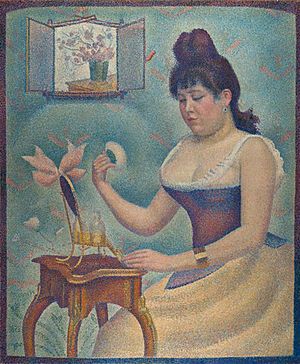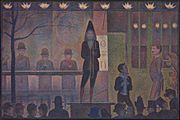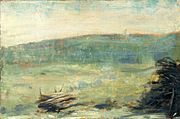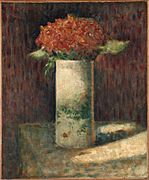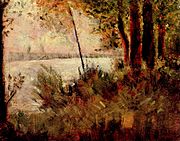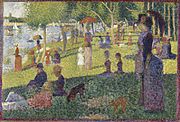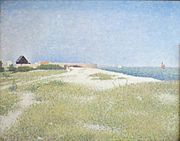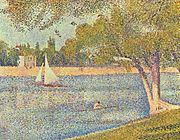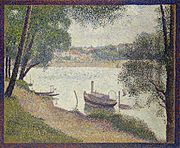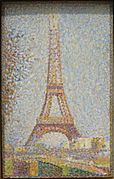Georges Seurat facts for kids
Quick facts for kids
Georges Seurat
|
|
|---|---|

Seurat in 1888
|
|
| Born |
Georges-Pierre Seurat
2 December 1859 Paris, France
|
| Died | 29 March 1891 (aged 31) Paris, France
|
| Nationality | French |
| Known for | Painting |
|
Notable work
|
A Sunday Afternoon on the Island of La Grande Jatte Bathers at Asnières List of paintings |
| Movement | Post-Impressionism, Neo-Impressionism, Pointillism |
| Partner(s) | Madeleine Knobloch |
Georges Pierre Seurat (born December 2, 1859 – died March 29, 1891) was a French artist. He was known for his unique painting style. He developed a special way of painting using tiny dots of color. This method is called "pointillism".
Seurat believed that the viewer's eye would mix these small dots of color together. He also made drawings using a special crayon called conté crayon. His famous painting, A Sunday Afternoon on the Island of La Grande Jatte (1884–1886), changed modern art. It helped start a new art movement called Neo-Impressionism.
Contents
Biography
Early Life and Art School
Georges Seurat was born in Paris, France, on December 2, 1859. His father, Antoine Chrysostome Seurat, was a wealthy former legal official. His mother was Ernestine Faivre. Georges had an older brother and sister.
Seurat started studying art at a local school in Paris. In 1878, he went to the École des Beaux-Arts. This was a famous art school. There, he learned by drawing old sculptures and copying famous drawings. He finished his art training in 1879. Then, he spent a year in the military.
After his military service, Seurat returned to Paris. He shared an art studio with his friend, Aman-Jean. For two years, he worked on mastering drawing in black and white. His first artwork shown to the public was a drawing of Aman-Jean in 1883.
Bathers at Asnières
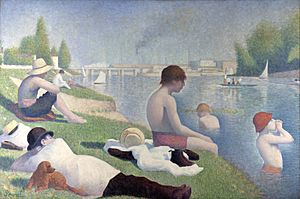
In 1883, Seurat began his first big painting. It was called Bathers at Asnières. This large artwork shows young men relaxing by the Seine River. The scene takes place in a working-class area of Paris.
The Paris art show, called the Salon, did not accept Bathers at Asnières. So, Seurat showed it at another exhibition in May 1884. Soon after, Seurat and other artists started a new group. It was called the Société des Artistes Indépendants. Seurat's new ideas about pointillism greatly influenced another artist, Paul Signac. Signac later adopted this dot-painting technique.
A Sunday Afternoon on the Island of La Grande Jatte
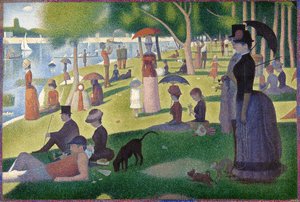
In the summer of 1884, Seurat started working on his most famous painting. It was titled A Sunday Afternoon on the Island of La Grande Jatte.
This painting shows people from different social classes enjoying a park. Seurat spent two years creating this large painting. He made many sketches in the park to prepare for the artwork. There are about 60 studies for the painting. A smaller version is also at The Art Institute of Chicago. The finished painting is also part of the Art Institute of Chicago's collection.
This famous painting inspired a musical called Sunday in the Park with George. It also appeared in the movie Ferris Bueller's Day Off.
Later Life and Art
Seurat had a relationship with Madeleine Knobloch. She was an artist's model. He painted her in his artwork Jeune femme se poudrant. They had a son named Pierre-Georges, born in 1890.
In the summer of 1890, Seurat painted on the coast at Gravelines. He created four canvases and several oil panels there.
Death
Georges Seurat died in Paris on March 29, 1891. He was only 31 years old. The exact cause of his death is not fully known. It may have been a serious illness like meningitis or pneumonia. His young son died two weeks later from the same illness. Seurat's last big painting, The Circus, was not finished when he died.
He was buried on March 31, 1891, at Cimetière du Père-Lachaise in Paris.
Colour Theory
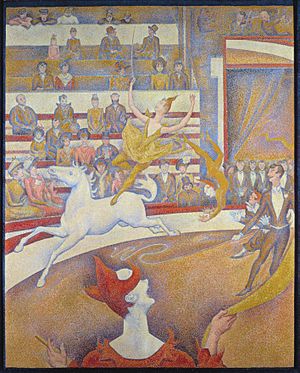
Seurat believed that artists could use color to create feelings in art. He thought it was similar to how musicians use notes to create harmony in music. He believed that using color scientifically was like a natural law. He wanted to prove this idea. He thought that understanding how we see colors could create a new art language. He called this language Chromoluminarism.
Seurat believed that:
- Joyful feelings could be made with bright, warm colors. He also used lines that pointed upwards.
- A calm feeling could be created with a balance of light and dark colors. He used a mix of warm and cool colors. He also used horizontal lines.
- Sadness could be shown with dark, cool colors. He used lines that pointed downwards.
Interesting Facts About Georges Seurat
- Seurat was very sensitive as an artist. He also loved logical thinking and precise, almost mathematical, art.
- In the 1880s, he listened to talks by a mathematician named Charles Henry. Henry discussed how lines and colors could create emotions.
- Seurat also carefully studied the works of another artist, Eugène Delacroix. He took notes on how Delacroix used color.
- Seurat's artworks later inspired the Cubist artists starting in 1911.
- On December 2, 2021, Google honored Seurat with a Google Doodle. This was for his 162nd birthday.
Paintings
-
Circus Sideshow (Parade de Cirque), 1887–88, Metropolitan Museum of Art, New York
-
Seurat, 1879–80, Landscape at Saint-Ouen, oil on panel, Metropolitan Museum of Art
-
Seurat, 1879, Flowers in a vase, oil on canvas, Fogg Museum
-
The Laborers 1883, National Gallery of Art Washington, DC.
-
Study for A Sunday Afternoon on the Island of La Grande Jatte, 1884–85, Metropolitan Museum of Art, New York
-
View of Fort Samson 1885, Hermitage Museum, St. Petersburg
-
The Seine and la Grande Jatte – Springtime 1888, Royal Museums of Fine Arts of Belgium
-
The Eiffel Tower 1889, California Palace of the Legion of Honor, San Francisco
Drawings
-
Child in White, 1884–85, Solomon R. Guggenheim Museum
Images for kids
See also
 In Spanish: Georges Pierre Seurat para niños
In Spanish: Georges Pierre Seurat para niños


